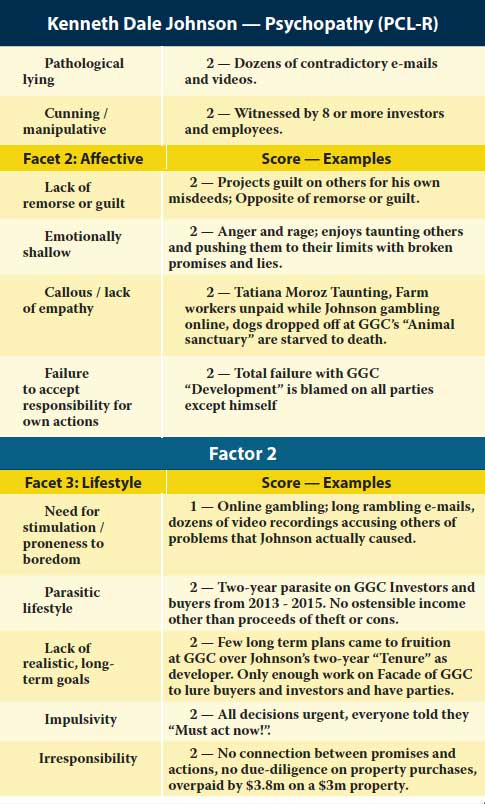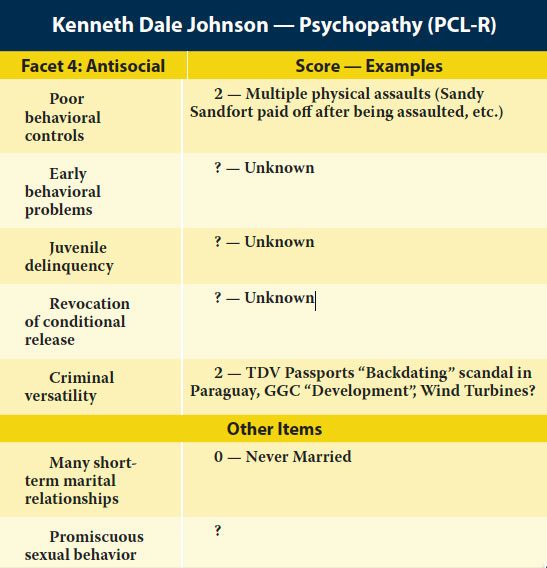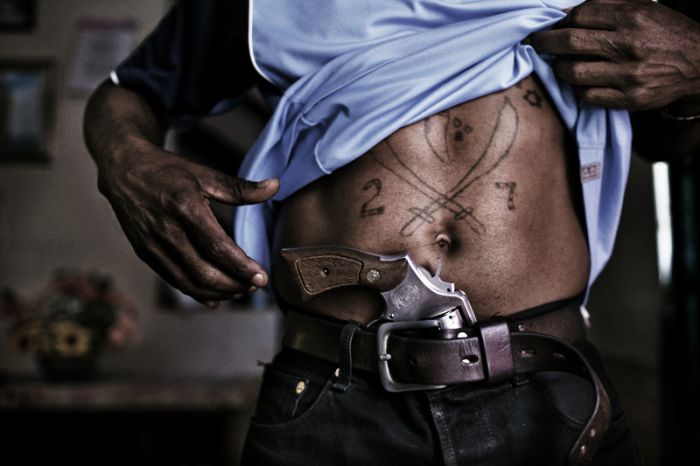Psychopaths are all the rage, lately. About 1% of the population meet the clinical criteria for psychopathy.1 That percentage rises to 3-4% in senior executives.2 Many articles and books list their attributes and behaviors. Still, advice on what to do about them is sparse.
I have an idea: use the new tool enabling psychiatrists to standardize their diagnosis and communicate accurately about such “patients”. That is, use the PCL-R (Psychopathy Checklist-Revised) to detect the potential psychopaths in your life. Then eject them before they have a chance to do the damage they seem born to do. You don’t have to be an expert to protect yourself.
If that seems harsh then avail yourself of the innumerable books and articles about these human predators. They rarely create anything but chaos. They’re usually parasites that rely on the productivity of others to supply for their every need. And yet, human hosts abound. Hosts, who don’t realize they’re facilitating their own demise until it’s too late.
I wrote a book about a suspected psychopath to thicken the non-fiction part of his résumé. He hasn’t been brought to justice, yet, but perhaps my book will put a digital noose around his neck, in the meantime. In Chapter 13 of “The Creature from Galt’s Gulch” I used eyewitness accounts to compare the suspect with Dr. Robert Hare’s PCL-R checklist for psychopathy.
Beginning of Book Excerpt
Johnson and the Psychopathy Checklist
Here’s a list of eyewitness accounts of Johnson and their correspondence to the attributes and behaviors on Dr. Robert Hare’s PCL-R checklist for psychopathy.
Preserving the term, “Psychopathy”
Words are often used with little respect for their original meaning. They’re used in propaganda and strung together in phrases that become memes. Memes are captured in social media, sitcoms, and movies. Within a few short years the word bears little resemblance to its original meaning. The first casualty is that the word in question may never recover it’s original, and most powerful, meaning. Even greater damage is done by obscuring the definition of a perfectly good word and thereby shrinking the vocabulary of humanity. It then takes that much more effort to communicate effectively.
We’re all familiar with the trivial use of the word “Fascist” hurled at anyone, and anything, the accuser may not like or that presents a maddening obstacle to their whims. Only when fascism describes the merger of corporate with state powers does meaning reappear. Another word that must be recovered to understand Galt’s Gulch Chile is “Psychopath”.
If your understanding of the word “Psychopath” is anyone acting in a way you don’t understand or agree with, then maybe the word “Psychotic” or “Psychosis” is a better fit. At the heart of the GGC story there sits a man exhibiting behaviors I believe (As a layman) to be consistent with the medical use of the term “Psychopath”. I refer to him as the “Creature” or Kenneth Dale Johnson. I have been careful to refrain from throwing the word “Psychopath” around in the irresponsible manner in which the word has become a cultural meme since 2010. That was when the Showtime series, “Dexter”, portrayed one as an ersatz hero. The word “Psychopath” is a medical term used to describe someone who lacks all empathy with their fellow man, someone who has no conscience, someone who can lie about millions of dollars of stolen money as if he were handing you an ice cream cone. It gets worse, but, let’s just leave it at that, for now.
As a layman, with no psychiatric medical training, I’ll stick with the PCL-R standard the professionals use to diagnose psychopathy. Dr. Robert Hare’s revised checklist for psychopathy is something I recommend all people become familiar with as a tool to assist in spotting, and then avoiding, the psychopaths that cross their path.
If there should be some kind of future “therapy” to shift the behavior of psychopaths towards that which, at least, acknowledges empathy with their fellow man (And not their pets or animals as is characteristic of the psychopath) then I welcome it. As of today, there is no such therapy that I’m aware of. The best course of action is to understand the behavior, recognize when they are being exhibited by someone, gauge the extent to which the person under consideration may be a psychopath, and avoid them in equal measure.
I believe that, unless Johnson ends up in jail, he’ll move on to live somewhere else in the world. May what’s been written here about the damage he’s done to so many people be added to his resume.
As of June, 2015 Johnson is making the mistake of recording himself on dozens of video updates he calls “Farm updates”. As with the rare movie, “I, Psychopath” where Sam Vaknin allows a filmmaker to create a documentary about him, this is a rare opportunity to study the behavior of a likely psychopath, in real time, and on video.
“Each of the 20 items in the PCL-R is scored on a three-point scale, with a rating of 0 if it does not apply at all, 1 if there is a partial match or mixed information, and 2 if there is a reasonably good match to the offender. This is said to be ideally done through a face-to-face interview together with supporting information on lifetime behavior (e.g. from case files), but is also done based only on file information. It can take up to three hours to collect and review the information. Out of a maximum score of 40, the cut-off for the label of psychopathy is 30 in the United States and 25 in the United Kingdom. A cut-off score of 25 is also sometimes used for research purposes. High PCL-R scores are positively associated with measures of impulsivity and aggression, Machiavellianism, persistent criminal behavior, and negatively associated with measures of empathy and affiliation.”
— Wikipedia entry for “Psychopathy Checklist”

With five categories unknown Kenneth Dale Johnson already rates a score of 29, in the collective recollection of those who’ve tangled with him. If correct, that makes him a psychopath in the UK and 1 point shy in the US. What do you think are the chances of him scoring a 0 in the unknown categories?
End of Book Excerpt
If you’re interested in the full story of Galt’s Gulch Chile the 186-page book is free for those who have access to the resource library.
Dealing with Psychopaths
You have two options:
- Detect and Avoid.
- Disentangle, Starve, and Extract.
Detect and Avoid
The unhired employee is the easiest to fire. The unentangled friend has no pretense to interfere. The unmarried crazy-maker is the easiest to divorce. Memorize the attributes of the PCL-R checklist so you can vet strangers that want to become more than strangers. Be on guard for anything over a score of 10 or for any attributes you find disturbing. Call former business associates and friends (If there are any). Did your candidate get along well with others? Did they show genuine empathy for other people? Would they do business with them again? Are they still friends? Just those four questions are probably enough.
I have a friend with an uncanny ability to detect the unseen factors about people and situations. She refers to it as her “Spidey Sense”. In the seven years I’ve known her she’s never been wrong. Now, when she tells me something is up I adjust my thoughts and actions to be in line with her intuitions. My friend has rare abilities. However, perhaps you can assemble a group of friends to achieve a similar result? Why not invite your candidate out for coffee for an informal vetting session?
Learning to recognize an aggressive move when somebody makes one and learning how to handle oneself in any of life’s many battles has turned out to be the most empowering experience for the manipulation victims with whom I’ve worked. It’s how they eventually freed themselves from their manipulator’s dominance and control and gained a much needed boost to their own sense of self-esteem. Recognizing the inherent aggression in manipulative behavior and becoming more aware of the slick, surreptitious ways that manipulative people prefer to aggress against us is extremely important. Not recognizing and accurately labeling their subtly aggressive moves causes most people to misinterpret the behavior of manipulators and, therefore, fail to respond to them in an appropriate fashion.3
Heavily Scrutinize Claims of Pain, Hurt Feelings, or Victimhood from Prospective Friends, Partners, etc.
Are they sharing a real experience or merely evoking feelings of sympathy to put you off-guard?
The tactics manipulators use can make it seem like they’re hurting, caring, defending, … almost anything but fighting. These tactics are hard to recognize as merely clever ploys. They always make just enough sense to make a person doubt their gut hunch that they’re being taken advantage of or abused. Besides, the tactics not only make it hard for you to consciously and objectively tell that a manipulator is fighting, but they also simultaneously keep you unconsciously on the defensive. These features make them highly effective psychological weapons to which anyone can be vulnerable. It’s hard to think clearly when someone has you emotionally on the run.4
Disentangle, Starve, and Extract
If you fail to detect or avoid a psychopath it will be much harder to get rid of them once they’ve embedded themselves into your life or business. It will be like trying to capture a spider while preserving the web. There will be people, assets, and money to preserve during the extraction. You can’t possibly care less about these things than your psycho already does. A psycho will think and feel nothing in “burning” through all of them just to see your reaction. Your best bet is to proceed slowly and document their every move so that contradictions and lies can be made visible to all. Get them talking and record everything (which is what psychos, themselves, are famous for doing). The biggest lies of their twisted premises must be debunked to the satisfaction of those who don’t yet see the spider for who they are. Those who don’t yet see through the psychos deceptions are unwittingly feeding the spider that will eventually bite them. In the meantime, the spider will continue to feed on the energy of those who still believe their lies. The idea is to cut off this source of the spider’s food so it eventually starves amidst a desert of unbelieving attention.
The ideal outcome is to have the spider eject themselves from the web. They will do so in huffs and indignant cries of counter-accusations. The psycho will go down with the ship repeating the same tired stories of how they have always been the victim and don’t care how many people don’t believe them. If you’ve done your homework such cries and accusations will now be seen and recognized by all to be ridiculous.
Of course, psycho extractions are rarely smooth and are difficult even when they can be done, at all. Perhaps Kent Kiehl’s, “The Psychopath Whisperer” can help. You may also enjoy Ann Barnhardt’s presentation on Diabolical Narcissism.
Their Words are Dead until You Make them Alive
Repeating the accusations of a psychopath makes dead words come alive. You are the source of that life. The more you repeat their words the more life the words have to impact the living. Stop repeating them, or even listening to them, and a psychopaths words remain dead in their own mouths. I’ve had personal experience with this.
A former boss of mine used to plant lies among his small group of five or so consultants. The point of his lies were to gain information from how each consultant reacted to them. I knew what he was doing but was never able to persuade the others to ignore his lies, altogether. When a co-worker would feel cornered into admitting to some trivial error the boss held it up as proof of the entire group being “liars”. That story reminds me of a simple and effective method for …
Extracting the Truth from a Psychopath
It’s easier than you think. Psychos are all blabber-mouths and can’t keep their own mouths shut. Your job is to listen and record. Then, translate their accusations as what they are: projected admissions of what the psycho, themselves, have done or are doing. It really is that simple. Psychos don’t so much create their own lies as much as they describe what they’ve actually done, and what their own motivations were. Then, a few names are swapped around, and fresh accusations can be launched. If cornered, your psycho will, of course, extend the web. But that be plausibly and quickly done with the inside knowledge of having been the original culprit.
Think of it this way: They’re not performing the mental feat of keeping track of multiple lies and the rippling consequences of multiple conflicting stories. They’re merely reciting from memory what they, themselves, have done.
Example
Psycho: “You’re a lying buffoon who has doctored up your resume with false experience while taking credit for the work that Joe and Marcia have done! You’re also using company money to pay for non-business events and expenses!”
You: Excellent. Now I know that my psycho has:
- Lied.
- Doctored up his resume
- Taken credit for Joe and Marcia’s work
- Used company money for travel, food, and events.
This is as close to a direct admission of deeds and guilt as your ever likely to get from your local psychopath. Enjoy it. Now you know exactly what they’ve been up to and how they mucked things up.
Herd Immunity from Psychos?
There is little hope or evidence that such creatures will self-correct and change their destructive ways. As with most problems facing humanity the hope lies in what changes the victims can make to avoid or neutralize the attack.
In the long-term, humanity must confront and overcome the following deficiencies if “Herd Immunity” is to be attained:
- A pervasive lack of awareness of their existence.
- Inability to diagnose and, therefore, to defend against, avoid, or thwart.
- No understanding of how they fit-in, demographically, with humanity.
- Apologetic denial that notorious figures of history were obvious and diagnosable psychopaths but my “friend” (Partner, Business Associate, City Councilman, etc.) is different.
- No spiritual discernment of the possibility that some people are just plain evil and that’s all there is to it.
- A knee-jerk tendency to dismiss outrageous behavior happening right in front of them.
- A tendency to take responsibility for outrageous behavior so as not to upset the guilty offender with the truth, or upset the sensibilities of the group.
- A long willingness to “Strike-a-Deal” to cap the bleeding despite an established string of lies.
Anyone wanting to avoid being victimized by covert-aggression must redefine the terms of engagement with a would-be manipulator. To do this effectively, one must: 1. be free of any harmful misconceptions about human nature and behavior, 2. know how to correctly assess the character of others, 3. heighten self-awareness, paying special attention to aspects of one’s own character that increase vulnerability to manipulation, 4. correctly recognize and label the tactics of manipulation and respond to them ap- propriately, 5. avoid fighting losing battles, and 6. know how to maintain a position of power and strength in interpersonal relationships.5
But, what about the short-term? What might you be able to do right now about the potential psychopaths in your life?
Adopt-A-Path
Ex-CIA agent Robert David Steele advised bloggers to adopt their own zip-code and illuminate whatever hanky-panky is going on.
“If you bloggers self-organize and attach yourselves like leeches to specific issues, corporations, organizations, challenges, whatever, you will be the intelligence minutemen of this century. The power is in your hands.”
Perhaps the same could done for Psychopaths or Diabolical Narcissists?
For those inclined I recommend being quite sure of the informal diagnosis of your adopted specimen. Preserve your integrity by using words and terms accurately. You won’t need to use hyperbole as there’s no need to exaggerate behavior that’s already quite outrageous. I’ve also learned from experience the many benefits of the writer having no ties, whatsoever, to the subject or their crimes. Human cooperation confuses the living daylight out of these creatures. They can’t understand something that’s not within them to ever do. I suppose that leaves them without much light, at all.
May it leave them with no victims, either.
- Hare, R. D 1994, ‘Predators: The Disturbing World of the Psychopaths among Us’,Psychology Today, vol. 27, no. 1, pp. 54–61 ↩
- Baibak, P; Hare, R. D Snakes in Suits: When Psychopaths Go to Work (2007) ↩
- In Sheep’s Clothing, Understanding and Dealing with Manipulative People, George K. Simon, Ph.D., page 8. ↩
- Ibid., 9. ↩
- Ibid., 93. ↩





